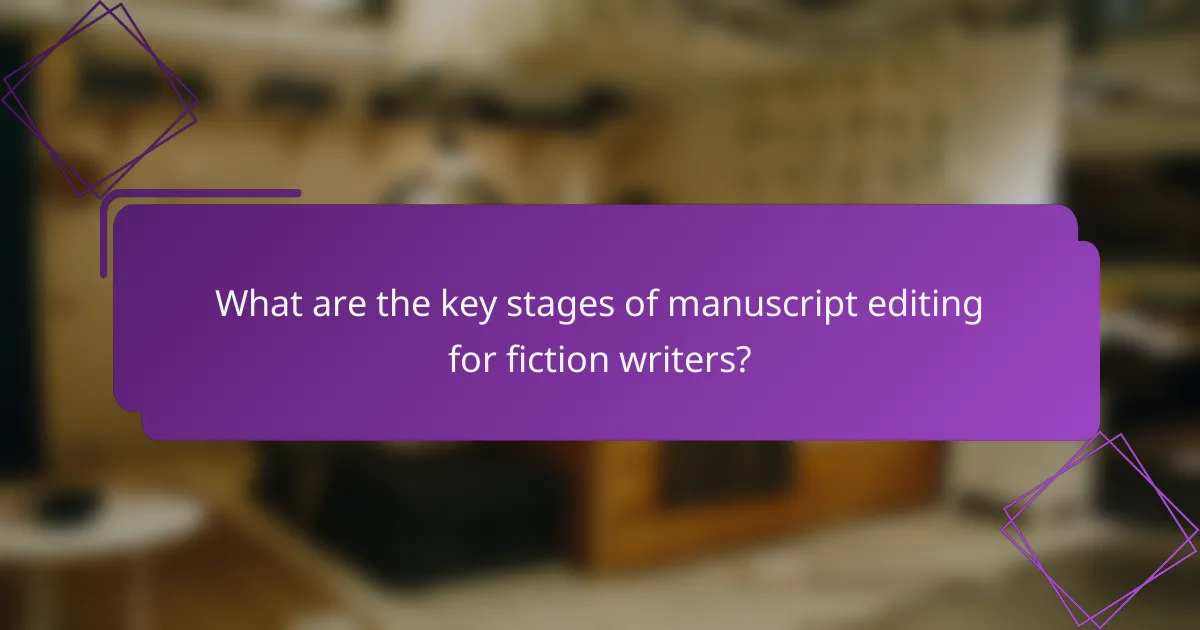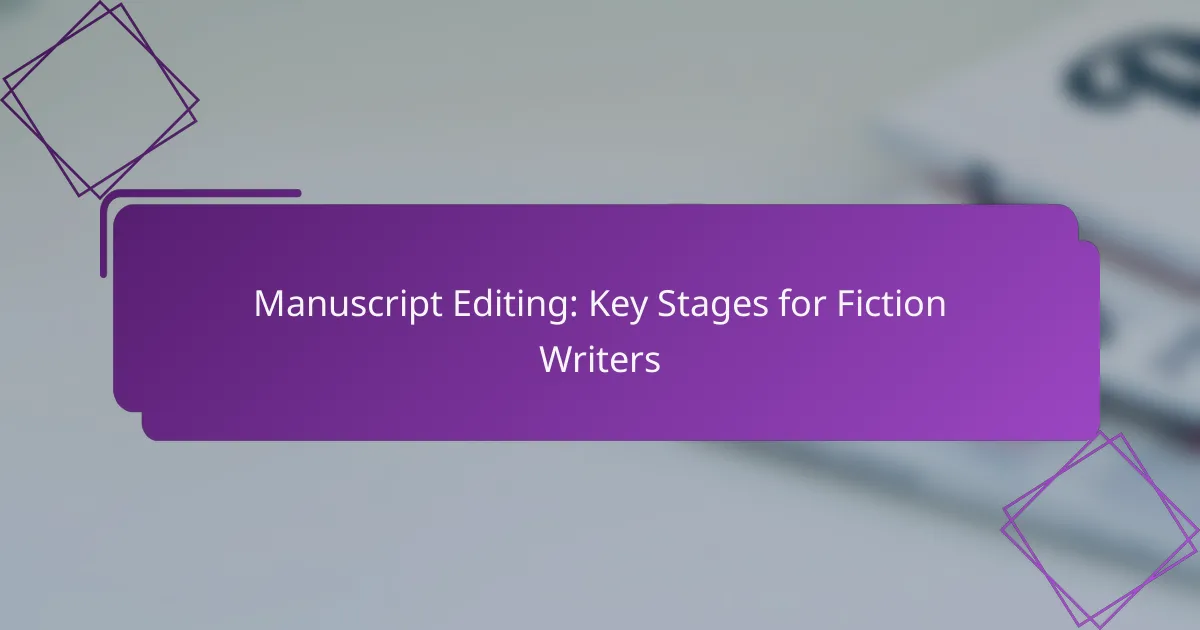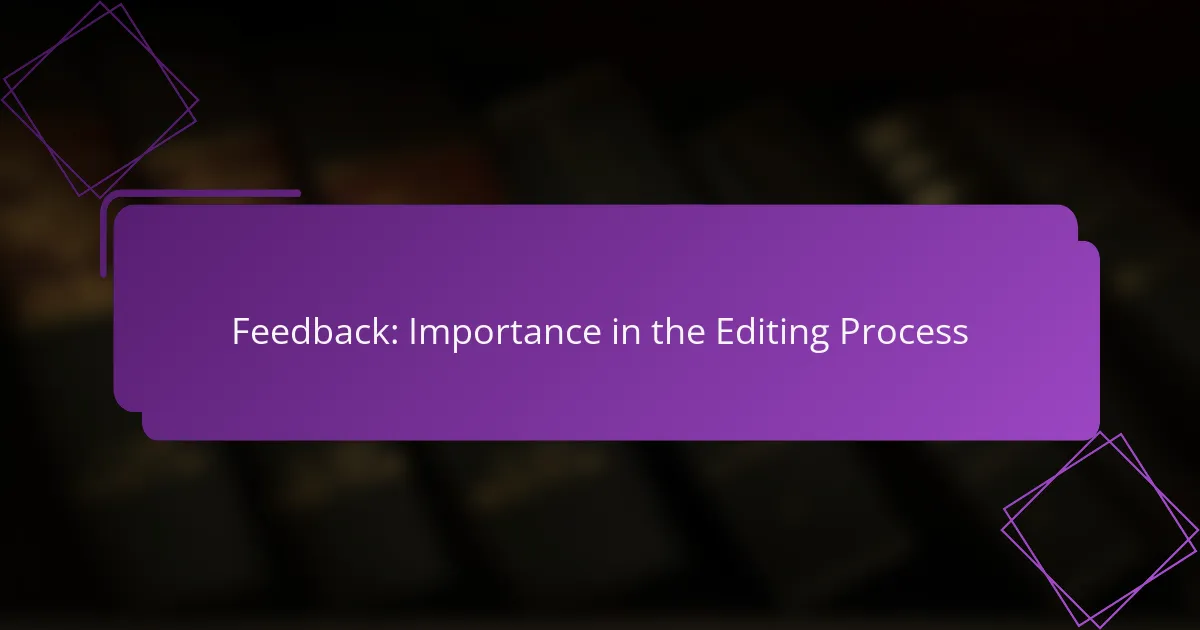Manuscript editing is a crucial process for fiction writers, encompassing several key stages that transform a rough draft into a polished final product. From developmental editing, which refines the story’s structure and characters, to line editing and proofreading, each phase addresses specific elements to enhance readability and engagement. Utilizing various editing tools can further streamline this process, ensuring that every aspect of the manuscript is meticulously crafted before publication.

What are the key stages of manuscript editing for fiction writers?
The key stages of manuscript editing for fiction writers include developmental editing, line editing, copy editing, and proofreading. Each stage focuses on different aspects of the manuscript, ensuring that the final product is polished and ready for publication.
Developmental editing
Developmental editing involves a comprehensive review of the manuscript’s structure, plot, and character development. This stage helps identify major issues such as pacing, consistency, and overall coherence, allowing writers to refine their narrative before moving forward.
During developmental editing, editors may suggest significant changes, including plot reorganization or character arcs adjustments. Writers should be open to feedback and willing to make substantial revisions to enhance the story’s impact.
Line editing
Line editing focuses on the manuscript’s language, style, and flow. Editors examine sentence structure, word choice, and dialogue to ensure clarity and engagement. This stage is crucial for enhancing the reader’s experience through effective prose.
Writers should pay attention to the rhythm and tone of their writing during line editing. It’s beneficial to read sections aloud to catch awkward phrasing or repetitive language. Consider using tools or resources that help identify overused words or phrases.
Copy editing
Copy editing is the stage where grammatical, punctuation, and spelling errors are corrected. This meticulous process ensures that the manuscript adheres to language conventions and is free from typographical mistakes.
Writers can benefit from utilizing style guides relevant to their genre, such as the Chicago Manual of Style or the AP Stylebook. Employing professional copy editors can also help maintain a high standard of quality in the final manuscript.
Proofreading
Proofreading is the final step before publication, focusing on catching any remaining errors or inconsistencies. This stage is essential for ensuring that the manuscript is polished and ready for readers.
Writers should approach proofreading with fresh eyes, ideally after a break from the manuscript. Reading the text backward or using digital tools can help identify overlooked mistakes. It’s advisable to have a second pair of eyes review the work, as they may catch errors that the original writer missed.

How does developmental editing improve a manuscript?
Developmental editing enhances a manuscript by refining its structure, characters, and pacing, ultimately leading to a more engaging story. This process involves a thorough examination of the narrative’s core elements, ensuring that they work cohesively to captivate readers.
Identifies structural issues
Developmental editing helps pinpoint structural problems such as inconsistencies, plot holes, or weak story arcs. By assessing the overall framework, editors can suggest necessary adjustments to strengthen the narrative flow.
Writers should consider the story’s beginning, middle, and end, ensuring that each part transitions smoothly into the next. Common pitfalls include introducing too many subplots or failing to resolve key conflicts, which can leave readers unsatisfied.
Enhances character development
Character development is crucial for reader engagement, and developmental editing focuses on creating well-rounded, relatable characters. Editors provide feedback on character motivations, arcs, and relationships, ensuring they resonate with the audience.
Writers should evaluate whether their characters undergo meaningful growth throughout the story. A helpful tip is to create character profiles that outline their goals, fears, and transformations, which can guide the editing process.
Improves plot pacing
Effective pacing keeps readers invested in the story, and developmental editing addresses areas where the narrative may drag or rush. Editors analyze the rhythm of scenes, ensuring that tension builds appropriately and that key moments receive adequate attention.
Writers can use techniques like varying sentence length and chapter structure to enhance pacing. A common strategy is to intersperse action-packed scenes with quieter moments, allowing readers to absorb the story’s emotional weight while maintaining momentum.

What tools can assist in manuscript editing?
Several tools can significantly enhance the manuscript editing process for fiction writers. These tools help identify grammatical errors, improve writing style, and organize content effectively, making the editing phase smoother and more efficient.
Grammarly for grammar checks
Grammarly is a widely used tool that focuses on grammar, punctuation, and spelling errors. It provides real-time feedback, allowing writers to correct mistakes as they type. The premium version offers advanced suggestions, including tone adjustments and clarity improvements.
To make the most of Grammarly, consider using its browser extension for seamless integration with various writing platforms. However, be cautious not to rely solely on automated suggestions; always review changes to maintain your unique voice.
ProWritingAid for style suggestions
ProWritingAid is an excellent resource for enhancing writing style and clarity. It analyzes your text for overused words, sentence length variation, and readability, offering actionable suggestions to improve overall quality. This tool is particularly useful for fiction writers aiming to refine their narrative voice.
Utilize ProWritingAid’s reports to focus on specific areas of your writing that may need attention. Regularly checking your work against its recommendations can help develop a more engaging and polished style over time.
Scrivener for organization
Scrivener is a powerful writing software designed for long-form projects, making it ideal for fiction writers. It allows you to organize chapters, scenes, and research materials in one place, facilitating easy navigation and editing. Its corkboard feature helps visualize story structure and character arcs.
When using Scrivener, take advantage of its outlining tools to map out your manuscript before diving into detailed writing. This can prevent structural issues and ensure a cohesive narrative flow throughout your work.

How to choose an editor for your manuscript?
Choosing an editor for your manuscript involves assessing their qualifications, compatibility with your writing style, and feedback from previous clients. A good editor can enhance your work significantly, so it’s crucial to make an informed decision.
Evaluate editor’s experience
When evaluating an editor’s experience, consider their background in editing fiction, including the genres they specialize in. Look for editors who have worked with authors similar to you or have a track record of successful publications.
Experience can often be gauged by the number of manuscripts they’ve edited, their familiarity with industry standards, and any relevant certifications. An editor with several years in the field is likely to have a better understanding of the nuances of storytelling and character development.
Check client testimonials
Client testimonials provide insight into an editor’s effectiveness and professionalism. Look for reviews on their website or platforms like LinkedIn, where past clients share their experiences.
Pay attention to feedback regarding communication, turnaround times, and the quality of edits. A pattern of positive testimonials can indicate a reliable editor, while consistent negative feedback may be a red flag.
Assess editing style compatibility
Editing styles can vary widely, so it’s essential to find an editor whose approach aligns with your vision. Some editors focus on structural elements, while others may emphasize line-by-line improvements or developmental feedback.
Consider requesting a sample edit or a consultation to gauge their style. This will help you determine if their methods resonate with your writing goals, ensuring a productive collaboration.

What are common mistakes in fiction manuscript editing?
Common mistakes in fiction manuscript editing include over-editing character dialogue, neglecting plot consistency, and ignoring feedback from beta readers. These errors can undermine the story’s authenticity and coherence, ultimately affecting reader engagement.
Over-editing character dialogue
Over-editing character dialogue often leads to unnatural conversations that feel forced or stilted. Writers may aim for perfection, but this can strip away the authenticity of characters’ voices. Instead, focus on maintaining a balance between clarity and realism.
To avoid over-editing, read dialogue aloud to gauge its natural flow. Consider using a few key phrases or quirks that define each character, allowing their unique voices to shine through without excessive polishing.
Neglecting plot consistency
Neglecting plot consistency can result in confusing storylines and character actions that don’t align with established events. This inconsistency can frustrate readers and disrupt their immersion in the narrative. Keeping track of plot points and character arcs is essential for a cohesive story.
Utilize tools like plot outlines or character sheets to maintain consistency throughout your manuscript. Regularly revisiting these documents can help you spot potential discrepancies before they become problematic.
Ignoring feedback from beta readers
Ignoring feedback from beta readers can hinder the editing process and prevent necessary improvements. Beta readers provide valuable insights into how your story resonates with an audience, highlighting areas that may need clarification or enhancement.
Actively seek and consider feedback, focusing on recurring themes in their comments. Create a checklist of common issues raised by beta readers and address these points in your revisions to strengthen your manuscript.

What is the role of beta readers in manuscript editing?
Beta readers provide invaluable feedback during the manuscript editing process, helping authors understand how their work resonates with potential audiences. They offer insights into plot coherence, character development, and overall engagement, which are crucial for refining a story before publication.
Provide reader perspective
Beta readers serve as the first line of audience feedback, offering a fresh perspective on the manuscript. They can identify areas where the story may lag, characters may lack depth, or themes may not be clear, which the author might overlook after multiple revisions.
When selecting beta readers, consider their familiarity with the genre and their reading preferences. A diverse group can provide a broader range of insights, helping to ensure the manuscript appeals to various segments of the target audience.
To maximize the effectiveness of beta readers, provide them with specific questions or areas of focus. For example, ask them to comment on pacing, character believability, or emotional impact. This targeted feedback can help you make informed revisions that enhance the overall quality of your manuscript.



